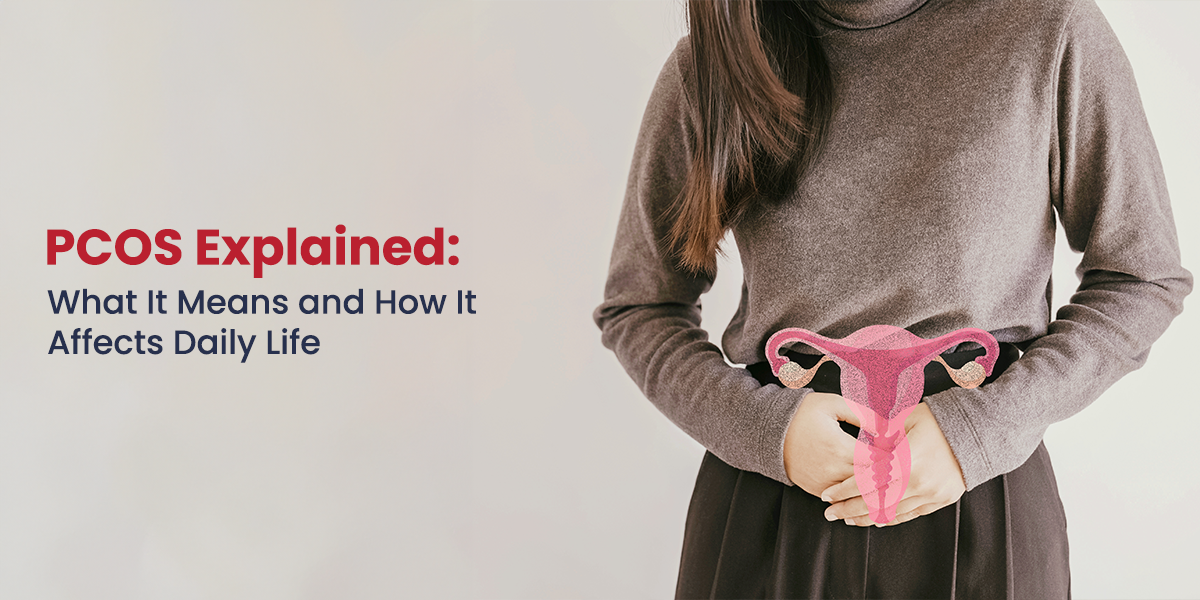PCOS Explained: What It Means and How It Affects Daily Life

Polycystic Ovary Syndrome (PCOS) is a widely prevalent hormonal imbalance found among women of reproductive age. It comprises a variety of symptoms and health complications that significantly impact one’s daily life. The blog will discuss what is PCOS, its symptoms, causes, diagnosis, treatment options, and how it affects the lives of those who have been diagnosed with it.
What is PCOS?
PCOS is a complex endocrine disorder that affects the function of the ovary. Polycystic means ‘having many small cysts’, usually seen in ultrasound. However, cysts are not mandatory for a diagnosis; in fact, many women with PCOS do not have cysts. Three indications characterise this disorder:
- Irregular cycles: Women with polycystic ovarian disease produce infrequent or rather long menstrual flow caused by irregular ovulation.
- Excess male hormones: Physical symptoms of increased male hormones are hirsutism, acne, and hair thinning.
- Ovaries with cysts: The ovaries measure larger than normal and have multiple underdeveloped follicles.
Polycystic Ovary Syndrome is estimated to affect about 1 in every 10 women of childbearing age, but many are not diagnosed due to a lack of awareness or mild symptoms.
Symptoms of PCOS
PCOS symptoms can differ greatly for every person. Such symptoms can include:
- Abnormal or absent periods: The majority of women having PCOS will experience irregular cycles or completely stop having periods altogether.
- Trouble in conceiving: Since ovulation is often irregular in this condition, it may be a problem for women trying to get pregnant. PCOS forms one of the leading causes of infertility in women.
- Unwanted Hair Growth: This is mostly defined as having too much hair on an inappropriate part of the body, such as on the face, chest, back, and thighs.
- Weight Gain: Many girls with PCOS struggle with their weight and are usually obese.
- Skin Problems: They have oily skin and are susceptible to acne due to hormonal imbalances.
- Thinning Hair: Some women may observe baldness on the scalp due to Polycystic Ovary Syndrome.
- Changes in Mood: Women with PCOS usually become depressed or anxious, as a result of the physical symptoms that affect self-image and self-esteem.
Usually, these symptoms first become visible to an individual during late adolescence or early adulthood and then may fluctuate with time.
Causes of PCOS
PCOS causes remain a mystery. There are various factors believed to contribute to the creation of this disease:
- Hormonal imbalance: Most women suffering from PCOS have high levels of male hormones, which later interrupt their normal ovulation.
- Insulin Resistance: Many females with PCOS have also been observed to be resistant to insulin. This is because the body’s cells do not respond correctly to insulin. Therefore, there is an increased amount of that hormone in the body compared to normal, and hence, androgen secretion.
- Genetics: Perhaps an ancestor in one’s family had PCOS; genetically, that becomes one of the predispositions for developing PCOS. Genetic factors play an important role in affecting the way PCOS manifests.
- Inflammation: Women with PCOS have been observed to display highly increased levels of inflammation, which result in elevated levels of androgens.
Suggested Read: What is PCOD? Everything You Need to Know About This Common Hormonal Disorder
Treatment Options for PCOS
There is no proper PCOS treatment available, still, you can follow these treatment options to reduce the symptoms:
Lifestyle Changes
Weight loss through diet and exercise can improve insulin sensitivity and restore menstrual cycles. Even a modest 5-10% weight loss can effect a significant change.
Medications
- Hormonal Birth Control: Any contraceptive method would help in regulating the menstrual cycle and prevent high androgen levels.
- Metformin: This drug affects insulin sensitivity and proves valuable in managing weight and menopause irregularities.
- Anti-Androgens: Drugs like spironolactone block the effects of androgens in the form of hirsutism and acne.
Fertility Treatments
Clomiphene citrate will encourage ovulation for women attempting conception. In some cases, assisted reproduction technologies, such as IVF, would be suggested.
Impact on Daily Life
Living with Polycystic Ovary Syndrome affects different levels of everyone’s daily life:
1. Physical Health
Most women suffering from PCOS are predisposed to several health complications later in life such as type 2 diabetes, hypertension, increased cholesterol levels, and the development of endometrial cancer. This is due to prolonged exposure to unopposed estrogen from irregular ovulation.
2. Emotional Well-Being
All the symptoms of PCOS can cause weight gain, hirsutism, and acne that can result in a poor body image and poor self-esteem. A good number of women experience anxiety or depression due to the conditions related to it.
3. Relationships
It influences some aspects of love relationships due to fears about fertilisation and emotional tension arising from physical symptoms. However, the most important thing is to communicate openly regarding these issues to keep relationships healthy.
4. Career Impacts
Cycles of menstruation and other health-related issues can sometimes incapacitate attendance at work, leading to an inefficient performance for most women. Planning for medical appointments and treatments does remain a matter of concern in managing time off.
You can consult about your PCOS in Regency Healthcare. They have the best gynecologist in Kanpur & Lucknow. They can provide professional support and help you to overcome PCOS.
Conclusion
Polycystic Ovary Syndrome is a common hormonal disorder (PCOS), which disturbs nearly every aspect of women’s health and day-to-day life. Awareness about what is PCOS, its etiological features, diagnosis, and therapy will educate women about how to seek care for the condition. Effective management and support from healthcare providers offer women suffering from PCOS the chance to live their lives fully without hindrances.

 Call-an-Ambulance
Call-an-Ambulance



